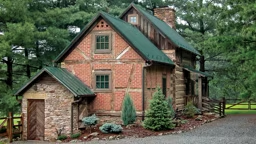Building a log home can be hard on the surrounding natural environment, particularly nearby trees. Here are some tips for protecting trees during log home construction.
People considering a log home welcome the opportunity to plan its look and layout, but how many think about the land it’s being built on? If you’ve bought an acre or more studded with mature trees, you probably can’t wait until the home is built so you can gaze out at the surrounding natural beauty. Imagine your horror when construction gets under way, and your builder unleashes chain saws and bulldozers to clear not just the site for the home, but also a wide swath for machinery and materials.
As you watch your wonderful woods disappearing, your only recourse is to pay a landscaper a small fortune to move in large trees and hope they take root, or else plant a slew of saplings and wait two or three decades for them to mature. Fortunately, this nightmare need never occur. Damage to mature trees can be kept to a minimum. The key to saving trees is to plan the clearing of your site and construction of your log home with the aim of preserving as many mature trees as possible.
Trees face three perils. Construction equipment can harm their trunks, earth-moving machinery can damage their roots, and heavy materials piled over the root system can damage it. What’s more, soil compaction and grade changes can kill a tree slowly, as long as five years after you move in.
To prevent these problems, draw a site plan that lists natural features. Identify specific stands of existing trees, highlighting particularly well-formed ones and their locations; open areas, dramatic vistas, streams, ponds and springs, problem areas — such as those subject to erosion; and other significant natural features.
Map the exact location of each tree worthy of consideration, noting its type, size and condition. Then recommend whether it’s worth saving, transplanting or removing.
Formulate a strategy for protecting trees, taking into account their location, health, species and aesthetic qualities, and evaluating them in relation to proposed site improvements. Consider not just the location of the log home itself, but also any septic system, utility poles, pipes and wires, driveways and walkways.
Draw up a tree-protection action key, showing each tree and whether it needs pruning, fertilizing, root pruning, mulching, transplanting or disposal.
Plot tree-protection zones: areas to be fenced off and flagged during construction. Designate areas to be used for parking and storing materials and equipment during construction. Trees to be saved need special care.
Before construction equipment appears, prune any limbs that might be in its way. Tree crowns may need to be reduced. Any trees being retained should be fertilized, watered and aerated.
Then erect fences with international orange flagging around them, not just to the point below a tree’s outermost leaves, but at least three times that distance. Most tree roots tend to run no deeper than six inches so they can get the air and water they need. Compaction can squeeze water and air from the soil, impeding trees’ ability to feed.
If you can’t keep machinery and materials off the root area, protect it with mulch or a combination of geotextile fabric and rock. Prevent concrete, oil or other harmful materials from being dumped where they can alter the soil’s chemical makeup.
Immediately treat any trees that are damaged during construction. Protecting trees doesn’t end when the construction crew leaves. Remove fences and signs, prune damaged trees, and water and fertilize them as necessary.
Then mulch to keep mowers away from tree trunks. Finally, inspect trees periodically to make certain they remain free from damage or disease.
Protecting Trees During Log Home Construction
Saving trees during construction of your log home can add to its aesthetic, monetary and environmental value.












